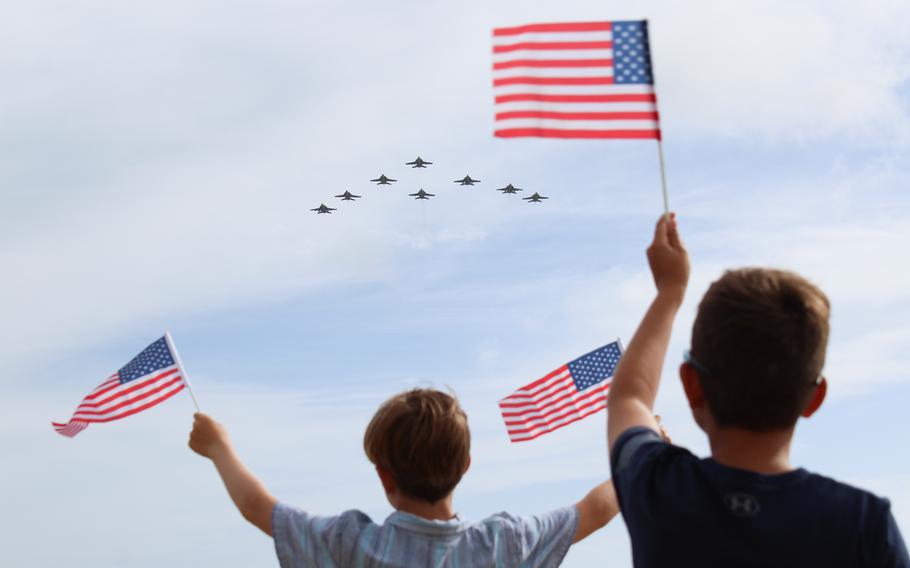
Dozens of family members gathered Friday, July 12, 2024, at Naval Air Station Oceana, Va., to welcome home four Virginia Beach-based fighter jet squadrons. The squadrons returned to the U.S. after nearly nine months on deployment with the USS Dwight D. Eisenhower Carrier Strike Group. (Caitlyn Burchett/Stars and Stripes)
VIRGINIA BEACH, Va. — “Who is going to run the fastest to Daddy?” Lynn Moreno asked her two daughters, 2-year-old Olivia and 4-year-old Anna.
The girls, in their matching Navy blue- and white-striped dresses, were among the people gathered Friday at Naval Air Station Oceana to welcome home four Virginia Beach-based fighter jet squadrons.
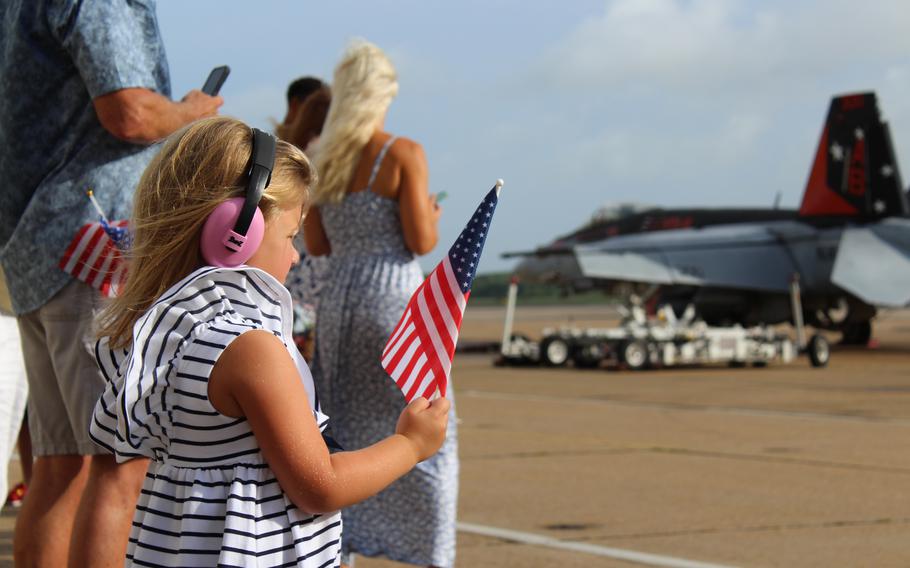
Anna Moreno, 4, plays with an American flag on Friday, July 12, 2024, while waiting for her father and F-18 pilot Cmdr. Jaime Moreno to return home. ( Caitlyn Burchett/Stars and Stripes)
A group of about 50 family members and friends erupted into cheers and vigorously waved American flags as the fighter jets — each unit in a V formation — appeared over the horizon.
The squadrons returned to the U.S. after nearly nine months on deployment with the USS Dwight D. Eisenhower Carrier Strike Group in the Middle East and Eastern Mediterranean Sea. Most of the time was spent in and near the Red Sea defending commercial and military vessels against Houthi drones and missiles launched from Yemen.
Capt. Marvin Scott, commander of the air wing, said the air wing and strike group responded “precisely and, when required, violently” to Houthi attacks on merchant vessels and military ships. The Houthi rebels are using adapted low-tech kits as one-way attack drones and anti-ship ballistic and cruise missiles to attack ships, he said.
“It was very dynamic. It was something we really have not seen — for the carrier strike group to be that close to that kind of fight — since World War II. It has been a constant evolution,” Scott said.
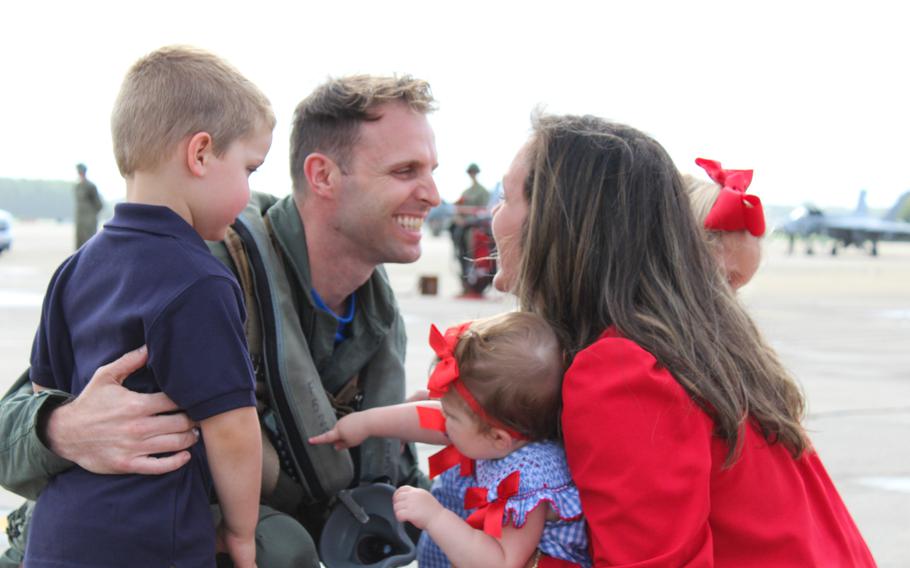
Lt. Mike Buck is greeted by his wife, Kristina, and children, 3-year-old twins Luke and Emma and 9-month-old Sofia. His unit, Strike Fighter Squadron 83 “Rampagers,” was one of four fighter jet squadrons returning from a nearly nine-month deployment with the USS Dwight D. Eisenhower Carrier Strike Group. (Caitlyn Burchett/Stars and Stripes)
Many of the aircraft returning to the air station Friday wore victory marks to showcase how many Houthi assets they had shot down during what several pilots described as “an intense deployment.” One jet from the “Wildcats” of Strike Fighter Squadron 131 had 11 missiles and two other munitions stenciled on its fuselage.
The group’s air wing expended 60 air-to-air missiles and released 420 air-to-surface weapons. All told, the strike group completed more than 13,800 flights totaling about 31,500 hours.
“The numbers and varieties of weapon expenditures are for the most part unprecedented, especially from the surface ships,” Rear Adm. Kavon Hakimzadeh, commander of Carrier Strike Group 2, said earlier this week.
He said the air wing numbers were about 1.5 times those expected during a full deployment.
“That hasn’t happened before,” Hakimzadeh said.
For the families back home, news headlines and limited contact with their loved ones brought worry each day.
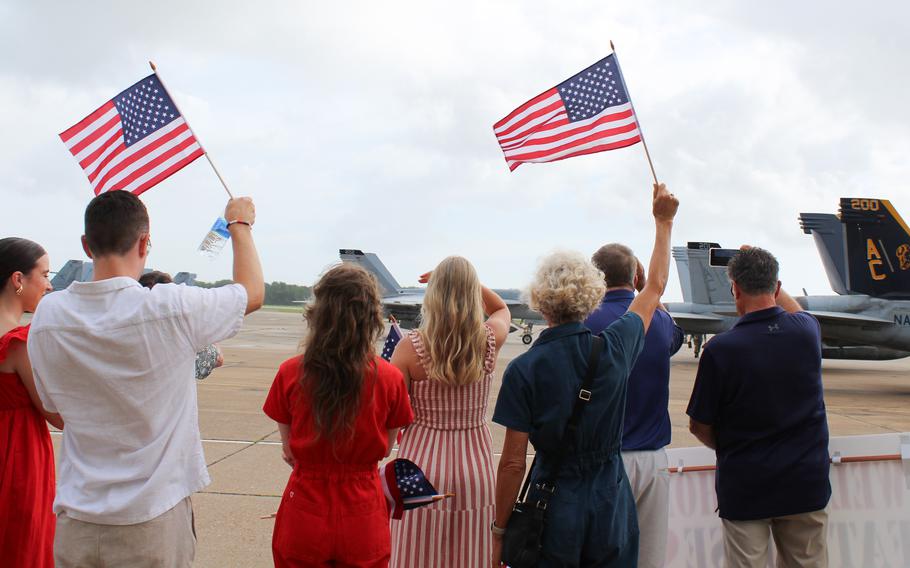
Dozens of family members gathered Friday, July 12, 2024, at Naval Air Station Oceana, Va., to welcome home four Virginia Beach-based fighter jet squadrons. The squadrons returned to the U.S. after nearly nine months on deployment with the USS Dwight D. Eisenhower Carrier Strike Group. (Caitlyn Burchett/Stars and Stripes)
“It has been frightening — him being part of it all,” Molly Girard said as she adjusted 1-year-old daughter Evie on her hip. Maggie Ruth, 3, clung to her mother’s dress as they waited to greet father and husband Lt. Cmdr. Britton Girard.
With two young children, Molly Girard said it was important that the stress of the deployment not impact the children. The family worked to communicate as often as possible, utilizing the ship’s Wi-Fi.
“We just had to wake up and take each day as it came,” she said.
Down the flight line, Cmdr. Andrew Stoner hugged his wife, Loren, and greeted fellow aviators. Stoner joined the deployment in April as the executive officer for Strike Fighter Squadron 131. He said because he arrived late to the fight, the deployment and overall mission was less intense for him.
“From what everyone said at the beginning, the intensity was mostly due to the fact that there were a lot of unknowns,” he said.
When Stoner arrived in April, the crew had already adjusted to the feverish pace.
“By the time I got there, everyone was used to it. Everyone knew what to expect and what to do,” Stoner said.
The Eisenhower received a combat action ribbon in April for performance under fire, among other awards. Six other Navy ships, including strike group members USS Philippine Sea, USS Gravely and USS Mason, also earned the ribbon.
Though the Eisenhower returned to the U.S., the threat continues. The USS Theodore Roosevelt, a West Coast-based aircraft carrier, will replace the Eisenhower carrier strike group in the Red Sea.
“A carrier strike group is the answer to these kinds of problems. It was very much a Navy fight,” Scott said.
Friday at the air station, Cmdr. Jaime Moreno dropped to the ground to wrap his two daughters in an embrace. He looked up at his wife, puckering his lips to give her a kiss for the first time in nearly nine months.
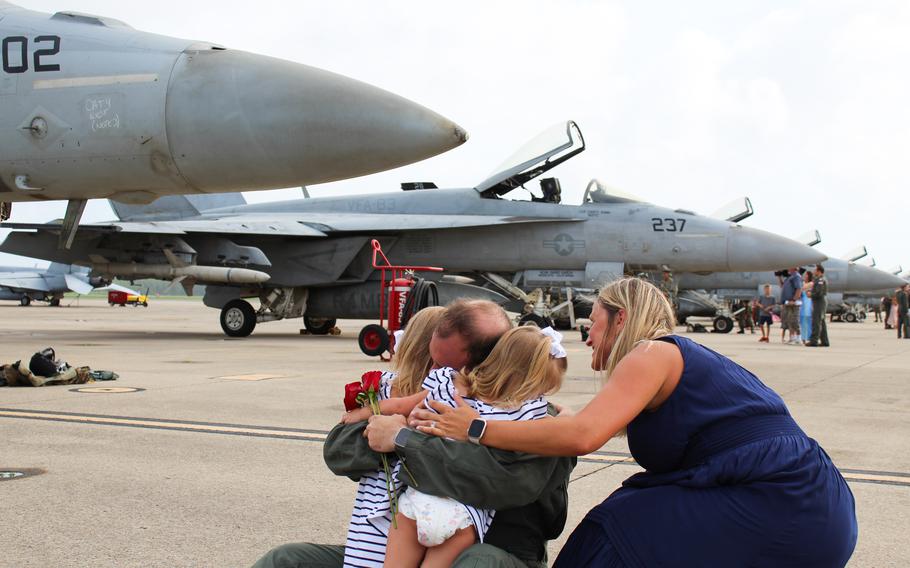
Cmdr. Jaime Moreno dropped to the ground to wrap his arms around his two daughters, 4-year-old Anna and 2-year-old Olivia, as his wife and their mother Lynn Moreno kneeled at their sides. Moreno, an F-18 pilot with Strike Fighter Squadron 83 “Rampagers” returned Friday, July 12, 2024, from a nearly nine-month deployment with the USS Dwight D. Eisenhower Carrier Strike Group. (Caitlyn Burchett/Stars and Stripes)
“It was a very long deployment, but we are incredibly proud of these guys and everything they have done for us and our country. We are thrilled to be able to welcome them home today,” his wife Lynn said.
The homecoming concludes what Moreno said was the most intense deployment he has experienced.
“But it was probably the most fulfilling deployment of my career,” he said. “When the call was placed, we were there to answer it.”
Stars and Stripes reporter Alison Bath contributed to this report.